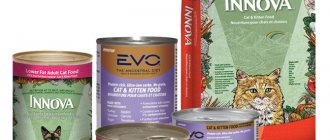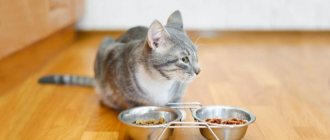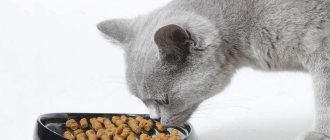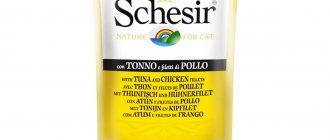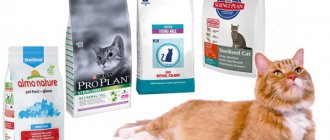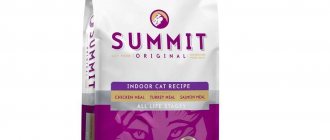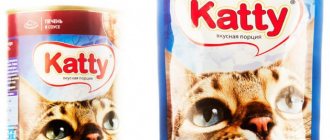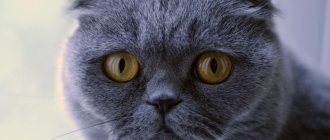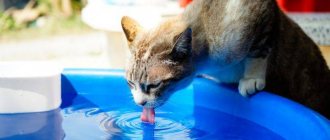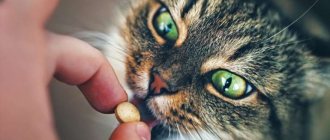Why industrial feed is the best choice for owners
Many owners of mustachioed pets, having got a four-legged friend, initially choose natural food for him, and then face many problems:
- difficulties with choosing quality products (free from GMOs, hormones and pesticides);
- the need to constantly cook for your pet takes a lot of time and effort;
- it is extremely difficult to provide the animal with all the necessary vitamins and minerals;
- Taken together, natural feeding is more expensive financially and is not always healthier for the pet.
Industrial feeds are superior to natural foods in all respects. However, in order to provide your cat with everything necessary, you need to know how to choose them correctly.
Natural or synthetic additives?
Economy class food contains a large number of harmful additives: artificial antioxidants and preservatives, taste enhancers, flavors and dyes - which is why cats eat them with great appetite. But these synthetic additives negatively affect many vital organs and literally gradually kill the cat. At the same time, such foods contain almost no or minimal vitamins, useful micro- and macroelements. Premium-class food will contain frankly harmful additives and flavor enhancers, but synthetic antioxidants and preservatives are possible in the composition. The vitamin-mineral complex is present, but it is quite poor. To produce super premium food, only natural preservatives and antioxidants are used; there are no artificial additives. The food is rich in vitamins and nutrients. The same can be said about holistics, only in this case the vitamin-mineral complex will be even more diverse and richer.
Classification of industrial cat food
By degree of humidity
1. First of all, industrially produced cat food is divided according to the degree of moisture:
Dry food
These products account for 80% of the industrial cat food market. At first glance, pads, granules or croquettes look like rather meager food, and therefore inexperienced owners often add dry food to their pets’ natural diet. In fact, dry food is a balanced and carefully selected diet that meets all the needs of your cat.
Wet food
They occupy 20% of the industrial feed market. They are sold in bags in the form of meat cubes moistened with jelly or sauce, as well as in the form of pates of various consistencies, packaged in bags or cans. This product is more expensive than dry food, but cats like it much more.
True, not all wet food is suitable as the main food. They usually supplement the main diet in the form of dry food. Only those wet foods that have a balanced composition and are marked “Recommended for the daily diet” on the packaging can be used for the daily diet.
Feed pellets vary in color, size and shape
By quality
2. Based on quality, all industrial feeds are divided into four classes
Important! The quality of industrial feed is assessed according to the American Fredalina scale. Experts take 100 points as a basis, and then adjust the level, deducting points for the presence of questionable or downright harmful components, and adding points for the presence of fruits, vegetables, probiotics and other beneficial components.
- economy (class D) – 70-77 points;
- premium (class C) – 78-85 points;
- super-premium (class B) – 86-93 points;
- holistic (class A) – above 94 points.
Important! Please note that on store shelves you can also find class F products, the quality of which does not reach 70 points. These are the cheapest foods, which means that if you care about your pet’s health, it is better to avoid such food.
Let's look at the advantages and disadvantages of each class of feed.
Choosing dry food: recommendations
After a thorough analysis, it is clear: no one should buy economy-class products, they are not cheaper than others, and they only bring harm to the cat. Premium does not bring any harm or benefit to a cat; you can live on it for a short time. Super-premium and holistic food are the best choice and even treat the pet, however, the latter can only be recommended to professional owners who are ready to share food with the cat, as they say, “from their table.” In general, it is impossible to give absolute advice on choosing food, because all cats and their owners are different, however, this article provides recommendations that will help you make your choice.
Economy class food
These are the cheapest foods, advertisements for which are most often seen on TV. The cheapest ingredients are used for their production.
There is no more than 4% meat in such a product, and its quality is highly questionable. It is not possible to find out what exactly is hidden under the vague formulation “meat and its derivatives”, “meal of animal origin” or “poultry meal”. Considering the low cost, we can assume that this is animal waste (ground skin, bones, hooves, beaks, tripe and other similar parts of animal carcasses). They contain a minimum of protein, which means they cannot serve as a worthy replacement for meat.
Corn gluten or vegetable protein extracts are used as a source of protein in such feeds. Both of these components are poorly absorbed by the cat's body.
The basis of such food is made up of cheap cereals without specifying the name. The packaging states “Cereals and herbal products.” Typically these are corn, soybeans and wheat, i.e. grains that often cause allergies in our furry friends. And even in this case, it is not whole grains that are used in feed production, but industrial waste with the lowest nutritional value.
Important! The components of economy-class food are absorbed by the cat’s body by only 60%.
Finally, economy-class food contains a minimal amount of vitamins and minerals. But they contain substitutes, flavor enhancers, preservatives BHT and BHA, as well as dyes, without specifying their origin, which also suggests that they are artificial. These additives provoke severe thirst in the animal, but what is even more dangerous is that they cause persistent addiction!
Economy class food
Cat food of this class cannot be called complete food. Of course, this is not “poison” for animals, and your pet will not be poisoned by it, otherwise such products would not have received approval for sale from Roskachestvo. Rather, these foods can be called “fast food” for animals. If you constantly feed your cat with them, there is a risk of encountering the following troubles:
- lethargy and apathy of the animal;
- digestive problems;
- dullness and hair loss;
- development of urolithiasis and other ailments.
List of brands
It is worth noting that most economy-class food is well known to owners of furry pets, since huge amounts of money are spent on advertising these products. These brands are: “Kitecat”, “Felix”, “Whiskas”, “Friskies”, “Gourmet”. However, those who purchase similar food for their pets should know that there are also less advertised brands, which in some ways are even superior to the above. These are the brands:
- "Purina One" (made in the USA, Italy, France and Russia);
- “Perfect Fit” (made in Germany, USA, Hungary and Russia);
- "Gemon" (made in Italy);
- “Cat Chow” (made in Hungary, Russia and the USA);
- “Statute” (made in Russia).
Types of feed by consistency
There are many types of feed consistency. To attract the attention of buyers, manufacturers produce pads with soft filling, jelly with granulated toppings, etc. The main types are considered: classic wet and granular food, as well as pate and canned food.
Dry food
Dry food is the most popular variety. Their consistency and preparation technology allow the inclusion of various additives: plant and animal extracts, vegetables, fruits, cartilage, offal, etc. This makes these feeds the most balanced. In most cases, they are suitable for daily nutrition in terms of meeting nutrient requirements, but much depends on the class of diet.
Ideally, dry food pellets should be dark due to the meat and slightly greasy
The advantages of this variety include ease of storage. In sealed packaging, the food can remain suitable for consumption for 2-3 years. Once the package is opened, the shelf life is sharply reduced to 4–8 weeks. This is only true if stored properly in airtight containers. If the packaging does not have a zip fastener, the oils can quickly go rancid. I had to deal with this when I bought large bags of feed to save money. I only have 2 cats living at home, so they don’t have time to eat 12 kg in a month. If the food goes rancid, pets begin to refuse food. This must be taken into account when choosing packaging.
The presence of dyes in granules is not welcome: they can irritate the mucous membranes of the gastrointestinal tract and have no nutritional value
The key disadvantage of dry food is the low level of humidity. Because of this, unaccustomed animals may refuse to eat during a sudden transfer. With a predisposition to diseases of the genitourinary system and gastrointestinal tract, as well as non-compliance with the drinking regime, the risk of developing pathologies increases. This is most dangerous for spayed or neutered animals, which often develop kidney and bladder stones.
Wet food
Wet food has a texture more reminiscent of meat, so it is often used as a supplement to the main diet when feeding natural products. The disadvantage of this variety is its meager composition: due to the limitations imposed by production technology, most often the list of ingredients contains only meat, fish and broth. Cereals and processed vegetable products can be added to cheap food. High-quality diets include fruits in small quantities.
It is strongly recommended to choose foods that resemble meat in appearance.
The shelf life of wet food is much shorter. After opening the package, the animal must eat the contents within 1–2 days. The maximum shelf life is possible only in sealed glass containers. If food is left in a standard bag, it will spoil faster.
Thick jelly from thickeners, unnatural color and lack of texture typical for meat are signs of poor wet food.
Wet food is rarely complete. Vitamins and minerals are added to economy class products, but this does not improve quality. It is also not recommended to use wet food for systematic feeding due to its consistency. The increased water content and soft pieces without hard fibers are ideal for indigestion, rehabilitation after surgery and diseases of the genitourinary system. However, with prolonged consumption of softened food, the animal’s paraanal glands may become inflamed. My friend’s cat’s pouches began to become clogged after six months of feeding him wet food. Despite the normalization of his diet and the consistency of his feces, exacerbations still bother him.
Canned food
Canned food can be conventionally called a subspecies of wet food. The key difference is in the storage container: while standard wet food is packaged in pouches, in this case metal cans are used.
Banks are often equipped with a special ring to make opening easier
Canned food usually weighs more, so the contents can be divided into several servings. However, after opening the can, the shelf life is sharply reduced to 12 hours due to increased oxidation of the metal. You can extend the period to 1–2 days using glass containers.
Pate
Pate is another subtype of wet food. It has a softer consistency and uniform texture. Pates are not recommended to be given to animals on an ongoing basis due to the increased risk of digestive disorders and inflammation of the anal glands.
Due to the lack of meat fiber, beneficial substances from the pate are less absorbed
When systematically eating pates and purees, the stomach becomes weaned from solid food. Due to the lack of fiber, the walls of the gastrointestinal tract are less cleared of rotting food debris. However, pates are well suited for unhealthy animals with intestinal diseases: they act as a gentle diet. The food can also be used in the postoperative period to prevent injury to the internal mucous membranes.
Premium food
You should not be impressed by the word “premium” in the name of the class, because in terms of its composition, these products are not very different from economy-class feed.
The content of animal proteins in this food is slightly higher - 4-10%, which significantly increases the digestibility of food. However, by-products and animal waste still prevail as meat ingredients.
The basis and main source of carbohydrates in premium foods are still soy, wheat and corn, which are poorly absorbed by the body of four-legged animals, and besides, they often cause allergies.
But in fairness, we note that when producing premium food, higher quality products are usually used. Cat food contains virtually no dyes or preservatives, and the composition itself is more balanced in terms of the ratio of fats, proteins and carbohydrates. Moreover, these products have a wider vitamin and mineral group, which makes the composition somewhat healthier.
Premium food
Finally, premium foods offer a wider variety of food textures. We know how picky cats are about the monotony of food, and they all periodically need a change in texture. In this regard, premium food undoubtedly wins.
Let us only note that the cost of premium feed is 2-3 times higher than the cost of economy class feed. And this price is not due to the increased quality of the food, but to the high costs of advertising!
Important! Premium-class food is “famous” for its heterogeneity in the selection of components, and therefore two products with the same price can differ dramatically in composition, both in one direction and the other. Therefore, when choosing such food, you should carefully study the composition of the product.
List of brands
When choosing the most optimal products of this class, we recommend paying attention to the following brands:
- "Hills" (produced in the Netherlands and USA);
- "Brit Premium" (made in the Czech Republic);
- "Eukanuba" (made in Russia);
- "Organix" (made in the Netherlands);
- "Probalance" (made in Russia).
Separately, it is worth mentioning two more brands - “Royal Canin” and “Pro Plan”. In terms of quality, they are no different from the brands listed above, but thanks to advertising, the prices for food of these brands are much higher.
What to look for when choosing food
Be sure to study the composition. The fewer impurities, dyes, preservatives and grain/soy additives, the better. The closer to the beginning of the list the name of the product, the higher its content in this food. What else should you pay attention to when choosing food?
| Look up the acronym AAFCO | It indicates that this product has not only passed the necessary tests of the American Feed Control Association, but also that the nutrients in this product are balanced. That is, the use of such food will provide your pet with everything it needs without “supplementary feeding” with natural food. |
| Protein (its nature) | If you see the word “protein” in the ingredients, then look to see if the manufacturer explains what kind of protein they use. And also whether there are percentages of its content. Conscientious manufacturers, who care not only about profit, but also about the buyers themselves, will always indicate the percentage content and type of this protein. |
| Feed quantity | Find out how much food you should give your pet. The lower this number, the better quality product you have in your hands. The high nutritional value of the food will provide your pet with the necessary energy. |
| Compound | Avoid products that contain bone meal, large amounts of grains or soy (they should not exceed half of the diet), many different dyes and preservatives. Give preference to those foods that contain not only vitamins (in particular E and C), but also liver and fish. This way you will provide your pet with iron and phosphorus, which are necessary for its bone and circulatory systems. |
| Best before date | Pay attention to expiration dates, as well as where and how the food was stored. |
Super premium food
These mixtures can truly be classified as elite feeds, since the quality of this product is an order of magnitude higher than economy and premium feeds.
The key advantage of super-premium food is that the source of protein in them is animal products. Meat and meat products in such compositions are at least 20%, due to which the digestibility of food by the body of four-legged pets is significantly increased.
Important! Super-premium food is made from first-class meat, as well as offal (heart, kidney, liver and tongue), of high quality.
Rice, oats or barley are used as grain crops in such feeds (less allergenic compared to corn or wheat). Some foods contain vegetable proteins from potatoes or peas, but corn gluten, which is common in cheap foods, is excluded!
A distinctive feature of super-premium food is its rich composition of vitamins and minerals, as well as the presence of natural vegetables that replenish fiber reserves. Flavoring additives, dyes and preservatives in such products are strictly prohibited! Even rosemary components and vitamin E are used as antioxidants.
Super premium food
To confirm the quality of such products, on the packaging of the feed you can always find detailed information about the ingredients present in the composition in percentage terms.
Important! Very often, super-premium products have breed, medical and dietary lines, the transition to which is usually prescribed by a veterinarian.
Specialists also took care of a variety of pellets for animals of different weights, sexes and ages. It’s safe to say that the producers of this food put animal health at the forefront!
List of brands
What is typical is that, in contrast to premium foods, in this group differences in composition are noticeably less common. The following brands have the most expressive price-quality ratio:
- "Summit" (made in Canada);
- "Leonardo" (made in Germany);
- "Brit Care" (made in the Czech Republic);
- “Fitmin For Life” (made in the Czech Republic);
- "Blitz" (made in Russia).
Meat content and balance of nutrients
The minimum acceptable percentage of protein in cat food per 100 g of product is 26%. However, volunteers and specialists of the Murkosha shelter, based on numerous studies and the opinions of veterinarians, draw your attention to the fact that this is the lower limit, the limit of the norm. It barely meets the cat's protein needs. The optimal protein ratio in the feed is about 40%. The minimum for fat is 9%, the maximum limit is 20%. In this case, the percentage of carbohydrates and fiber should ideally be in the range of 10-20%. Almost all professional cat foods meet at least the minimum protein content requirements. However, manufacturers achieve this in different ways.
In economy-class cat food, the first ingredients in the composition are usually wheat and/or corn flour (or wheat/corn gluten). These ingredients contain enough protein to meet the minimum daily requirement. In this case, it turns out that almost all the proteins consumed by the cat are of plant origin. It would seem, what's the difference? But animal and plant proteins have different compositions of amino acids (basic nutrients used by the body). For example, plant foods contain too few essential amino acids such as lysine and arginine. As a result, the value of plant proteins is only 60-80% compared to animal proteins. In other words, formally the protein content is normal, but in fact it is not enough. Of course, economy-class cat food also contains meat, although it would be more correct to say “meat” in this case. In the description of the composition of such feeds, there are extremely vague formulations like “meat and its processed products”, while the manufacturer is silent about the percentage of meat and what percentage of “processed products”. And what exactly is hidden behind the words “meat processing products”? Practice shows that to produce economy-class food for cats, waste from the meat industry is used, something that is unsuitable for human nutrition: skin, ears, tails, sinews, as well as bone meal in large quantities. Of course, your pet will not receive any beneficial substances from such a set of ingredients.
With premium food, things are somewhat better. Although the percentage of proteins is still closer to the minimum limit, and some of them are also of plant origin (however, there is much less wheat and corn, potato and pea proteins are often used instead), meat already appears in the composition. However, even here one cannot do without vague formulations like “chicken”. We would like to warn you that “chicken meat” and “chicken” in the composition are not exactly the same thing. “Chicken meat” is exactly that: meat: what a cat needs to eat. And the concept of “chicken” in this context can include both meat and offal (including those that are not usually eaten by humans), and even bones. After all, it all comes from chicken, right? This means that the manufacturer provided (formally) correct information. Pay attention to this trick! Although this is still better than waste and bone meal, which are used in feeds of a lower class. In other words, there is meat in premium cat food, but its quantity is not enough for a predator’s diet, and the quality could be better. The balance of necessary substances is generally maintained.
Read more: Composition of dry cat food: let’s look at the nuances
We see a completely different picture when we move on to super premium food. The protein content becomes close to optimal (in the range of 30-35%), and in the worst case, a small part of them is plant-based (there are also completely grain-free foods). That is, the basis of the feed is meat and high-quality offal (heart, liver, kidneys), which are also necessary as a source of a number of useful substances. Super premium food is fully balanced and meets the nutritional needs of cats.
Holistics are even more consistent with the ideal diet for cats (the diet of the wild ancestors of cats in their natural habitat can be taken as a reference). There is even more meat in the composition - up to 75-85%! At the same time, manufacturers accurately calculate the proportions so that the ratio of meat itself and high-quality offal meets the needs of the cat. To make holistic products, only fresh or dehydrated (dehydrated) meat or fish fillets are used, and manufacturers combine several meat ingredients (for example, duck, rabbit and lamb). Of course, all proteins of animal origin and grains are usually absent from the composition.
Holistic food
This class appeared relatively recently (no more than 20 years), but literally immediately took a leading position among the highest quality cat food.
This is quite obvious if you consider that the main component of such food is fresh (not frozen meat), and exclusively turkey, venison, lamb, lamb, duck, and in rare cases, chicken. Fatty meats such as pork and beef are not used in this class of food. At the same time, the quality protein present in holistic food ranges from 20% to 50%.
Holistic food is distinguished by a decent vitamin and mineral complex, the presence of amino acids, probiotics and prebiotics, which are used in the form of natural supplements. We can say that among all classes of food, this product is the most balanced for the body of four-legged friends.
Important! Holstik feed components do not contain GMOs, antibiotics or hormones.
Cheap fillers, such as wheat and corn, are absent in such food. Many manufacturers of this high-quality food do not include grain components at all. And natural fruits and berries (occasionally beets) are used as fiber. If grain is present (lentils, rice), then its share does not exceed 10%.
Even safe synthetic flavor enhancers in holistic foods are prohibited, which means that such food has a natural taste. By the way, for this reason, some cats are reluctant to eat this food, especially if they were previously given economy-class food with artificial flavor enhancers.
Important! Without exception, all holistic foods are made according to the Human Grade system, which means from products that are used for the human table. It is not surprising that the digestibility level of such feeds exceeds 80%.
Naturally, this class of food does not use gluten or other components that can cause allergies in four-legged friends. We can say that absolutely all holistic foods are hypoallergenic. Particular attention should be paid to the packaging of this product, which lists all the ingredients without exception (for convenience, arranged in descending order).
Almost all holistic food manufacturers have lines for cat breeds and age groups. In addition, medicinal feeds are produced (depending on certain diseases), as well as feeds for preventive purposes.
Important! All holistic products are certified and have a quality guarantee.
List of brands
Among the brands of these products I would like to highlight:
- "Grandorf" (made in France, Belgium);
- "Carnilove" (made in the Czech Republic);
- "Farmina N&D" (made in Serbia, Italy);
- "Go Natural" (made in Canada);
- "Acana" (made in Canada).
Availability of cereals
As for grains, the principle is this: the less of them in cat food, the better. We have already talked above about the dangers of replacing animal proteins with plant proteins. But there are a number of other reasons why grains, and especially wheat and corn, are undesirable for cats. The fact is that they contain a lot of carbohydrates (up to 70%). And carbohydrates sharply increase blood sugar levels. The cat's body is not adapted to such sudden jumps in glucose levels, so foods high in carbohydrates can lead to the development of diabetes mellitus and even kidney and liver failure in the pet.
More about diabetes: All about diabetes in cats.
Another reason why grains are not advisable is that cats often have an allergic reaction to corn or wheat gluten.
Read about food allergies: Food allergies in cats
All these shortcomings are fully manifested in economy class feed. But to some extent, what has been said is also true for the premium class, although there, of course, the percentage of grains is much lower. Super premium food for cats and kittens usually contains minimal amounts of grains or none at all. And even if they are, most often it will not be wheat and corn, but, for example, rice and oats - much less harmful. In holistic medicine, grains are completely excluded (as well as potato and pea protein). Vegetables, fruits, berries and lentils are sources of carbohydrates and fiber. There are also medicinal herbs in the composition.
What you need to know about the composition of feed
Now let’s talk about the intricacies of food of various classes, which will help you not make a mistake in your choice:
- Always study the composition of the food indicated on the packaging. For quality feeds, the ingredients are indicated as a percentage and in descending order. The absence of this information indicates that this is a product of dubious quality.
- The packaging of high-quality food always indicates what kind of meat was used in its production. If there is no such decoding, this is a lower-than-premium product.
- Pay special attention to identifying the meat component. The mark “dehydrogenated” will indicate that the amount of meat in the feed corresponds to its presence. The absence of such a mark will indicate that the meat in the mixture has a raw appearance, and its quantity is 3 times less than indicated on the label.
- From the feeds, it is better to choose the one whose packaging contains a breakdown of the by-products used in its composition (liver, lungs, heart). The label “animal products” most likely indicates that bones, beaks, hooves and skin were used as by-products.
- Cats are carnivores by nature, which means the lower the grain content in the food, the better.
- The presence of berries and fruit mixtures, probiotics and prebiotics in the composition indicates the high quality of the product.
- The presence of soy or soy concentrate in the feed is undesirable. Along with corn, this product often causes allergies in members of the cat family.
- The mark “poultry” or “animal” fat in the mixture indicates its low quality. A quality product usually lists “fish” or “chicken” fat.
- If your pet has undergone sterilization or castration, if he suffers from obesity or urolithiasis, therapeutic and preventive food will be optimal for him.
- Pregnant and lactating cats will need food with a higher calorie content. Manufacturers of high-quality feed, as a rule, have corresponding lines.
Finally, remember that regardless of the quality of the food purchased, your pet should have free access to water. It will protect your four-legged friend’s body from dehydration!
Types of feed depending on the age of the animal
In most lines of holistic classes there is no division into age categories of animals. In the case of the super-premium category, this occurs, but rarely. The production of products for animals of different ages is more typical of low-quality brands, since good food is suitable for all healthy pets. Traditionally, manufacturers develop formulations for kittens, adult cats and elderly pets.
Kitten food
Kittens require more calories and nutrients (vitamins, minerals and amino acids) as their internal organs and systems actively develop. Useful compounds are used as building materials for fabrics. If an adult animal can tolerate nutritional deficiency for a long time without critical consequences, then in the case of kittens, even 5–7 days at an early age (1–2 months) can cause the development of chronic diseases.
Despite the manufacturer’s assurances, it is better not to give Whiskas food to kittens: such nutrition will lead to the development of pathologies even at the time of the final formation of internal organs
Kitten foods often include fish oil, salmon oil and tocopherols in high concentrations. Unsaturated fatty acids and vitamin E help improve immunity and the condition of the nervous system. Some manufacturers use dairy products and extracts as a replacement for mother's milk. They partially supply the kitten’s body with antibodies.
The fact that the food is suitable for kittens may indicate
For small kittens, wet food is preferable. It is close in consistency to regular food, so the gastrointestinal tract adapts gradually. Dry food can also be given to kittens after a month, but it is recommended to soak it first.
Food for adult cats
Foods for adult cats are universal standard products that have an average concentration of nutrients and normal calorie content. Such diets are suitable for almost all animals without special needs. They can be given even to elderly pets in the absence of problems with excess weight, if the composition includes preventive supplements.
The “Adult” mark indicates that the food is suitable for adult cats.
Food for older cats
Manufacturers recommend giving food to older cats from the age of 7 years, but in reality, with good care and normal health, the animal may only need the diet after 10–12 years. Most often, such diets reduce calorie content by reducing the proportion of fat. This helps to simultaneously reduce the load on the liver and prevent excess weight.
Manufacturers may indicate recommended age limits on packaging
Obesity is quite common in older cats due to decreased activity. Excess weight at this age poses a great threat, since it can increase the load on the joints. In old age, problems with the musculoskeletal system often appear. To prevent damage to cartilage and joints, manufacturers include sources of glucosamine and chondroitin in the food: cartilage, mussel extract, crab shells, etc. However, diets with such additives are recommended to be given to young cats, since they may not help at an older age.
The “Senior” label may indicate that the food is suitable for older cats.
Older cats, like kittens, should be given wet food if they have chronic diseases. This will reduce the severity of symptoms in gastrointestinal and oral pathologies. In such cases, spiders are combined with dry food, but given at different times so as not to provoke digestive upset.
Advice and reviews from veterinarians
- Do not under any circumstances mix ready-made food with natural products, this can lead to problems with the pet’s stomach and digestion;
- If your cat eats dry food every day, he also needs to drink drinking water every day with his food;
- In order for canned food to become more aromatic and tasty, they must be heated to 40oC;
- If your pet is sick, use only medicated food;
- Remember, cats like dry food that has smaller granules;
- If you feed your pet natural products, never salt them. This may harm the pet;
- Remember that if your animal is castrated (or sterilized) under no circumstances should it be given fish;
- Raw meat can be consumed by animals, but only after refreezing;
- Sausages and sausages, as well as pork, are strictly prohibited for cats.
In conclusion, I would like to note that no matter what food you choose for your pet, do not forget to provide it with clean drinking water. If you still find it difficult to choose food or diet for your pet, be sure to contact your veterinarian.
How to feed
Feeding a cat with dry food should only be done if the cat has constant access to drinking water. In conditions of constant feeding on dry food, the cat must consume a large amount of liquid per day.
If she drinks little, it is better to give up the dry diet.
The norm is to feed food from the same manufacturer so that the pet does not have to get used to different foods. If for some reason the crispy pads do not impress the cat or cause an allergy, you can try products from another manufacturer or switch the animal to a different type of food.
There are two ways to transfer a cat from one diet to another (natural food is preferable).
The first way to switch a cat to another food is radical and requires getting rid of all types of ready-made treats. If a pack of aromatic crisps remains in the cupboard, it will not be possible to move the cat, since he will smell and ask for his usual food.
The second method suggests a gradual reduction in portions of dry food and an increase in the proportion of natural food. It will be easier to switch your cat to another food using this method. At first the cat may refuse to eat in both cases, but after a few days hunger will overcome pride and the cat will begin to eat.
Advantages and disadvantages
Veterinarians often recommend dry food for
Super-premium and holistic class cats, because they have a lot of positive qualities:
- Feeding your cat dry food is very convenient, as it does not take much time. It is enough to pour crunchy balls into a bowl a couple of times a day, the cat will do the rest himself;
- pets treat dry food with a special aspiration and are ready to jump around the kitchen at the mere sight of a package of food in the hands of the owner;
- high-quality dry cat food has a perfectly balanced composition, so the cat does not need additional vitamin complexes;
- dry food is stored for a long time, so you don’t have to worry that food opened today will become unusable tomorrow;
- the texture of this food has a good effect on your pet’s teeth, protecting them from plaque and the formation of tartar.
Dry cat food is good enough, but not ideal, because it has its drawbacks, like other types of food:
- if the cat consumes little liquid, then you should not feed it only dry food;
- high-quality dry food is quite expensive, and feeding a cat cheap “dry” food can result in terrible diseases of the gastrointestinal tract;
- It is better to select food in accordance with the age and health of the pet. If you feed your kitten dry food for adult cats, problems may arise;
- After feeding dry food for a long time, it will be difficult to switch the cat to another type of food.
It is normal for an owner to be unsure whether to feed their cat dry food. Regardless of what food the cat owner chooses, it is important to pay sufficient attention to feeding the pet. So, you need to feed your cat dry food in accordance with certain rules.
Conclusions and recommendations
If we briefly characterize the different classes of cat food:
1. Economy - instead of meat, waste from the meat processing industry is used, almost all protein is of plant origin, its source is rather harmful wheat or corn gluten. The composition as a whole is poor, there are a lot of harmful components. 2. Premium – meat is present, but not enough; there are proteins of both animal and plant origin. There are significantly fewer artificial additives, but the composition is still poor in terms of nutrients. 3. Super premium - the composition is based on meat, it is enough to meet the needs of a cat, almost all proteins are of animal origin. There is no or minimal amount of wheat or corn gluten, but small amounts of potato and pea protein may be present. The composition is enriched with vitamins and minerals. 4. Holistics - a completely natural composition, as close as possible to the ideal diet for cats. Very high content of meat (or fish), no gluten or protein of plant origin. The composition is enriched with vitamins and minerals.
Based on everything said above, we categorically object to the use of economy-class food as food for cats. We don’t recommend the premium class either - although there is no particular harm, there is also little benefit. But super premium class and holistic services would be the best choice.
At the Murkosha shelter, cats and kittens receive super premium food because we care about their health. This diet allows them to be healthy, vigorous and active. So if you are thinking about what to feed your kitten, food of the “super premium” class and above is just what you need. An adult pet should also be switched to them if he currently eats foods of a lower class. Remember that your pet's health is entirely in your hands!
